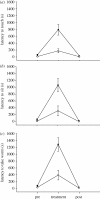Learning capabilities enhanced in harsh environments: a common garden approach
- PMID: 20519218
- PMCID: PMC2982060
- DOI: 10.1098/rspb.2010.0630
Learning capabilities enhanced in harsh environments: a common garden approach
Abstract
Previous studies have suggested that the ability to inhabit harsh environments may be linked to advanced learning traits. However, it is not clear if individuals express such traits as a consequence of experiencing challenging environments or if these traits are inherited. To assess the influence of differential selection pressures on variation in aspects of cognition, we used a common garden approach to examine the response to novelty and problem-solving abilities of two populations of black-capped chickadees (Poecile atricapillus). These populations originated from the latitudinal extremes of the species's range, where we had previously demonstrated significant differences in memory and brain morphology in a multi-population study. We found that birds from the harsh northern population, where selection for cognitive abilities is expected to be high, significantly outperformed conspecifics from the mild southern population. Our results imply differences in cognitive abilities that may be inherited, as individuals from both populations were raised in and had experienced identical environmental conditions from 10 days of age. Although our data suggest an effect independent of experience, we cannot rule out maternal effects or experiences within the nest prior to day 10 with our design. Nevertheless, our results support the idea that environmental severity may be an important factor in shaping certain aspects of cognition.
Figures


Similar articles
-
Variation in memory and the hippocampus across populations from different climates: a common garden approach.Proc Biol Sci. 2012 Jan 22;279(1727):402-10. doi: 10.1098/rspb.2011.1020. Epub 2011 Jun 29. Proc Biol Sci. 2012. PMID: 21715407 Free PMC article.
-
Overwinter temperature has no effect on problem solving abilities or responses to novelty in Black-capped Chickadees (Poecile atricapillus).Behav Processes. 2019 May;162:72-78. doi: 10.1016/j.beproc.2019.01.012. Epub 2019 Jan 31. Behav Processes. 2019. PMID: 30711620
-
Variation in brain regions associated with fear and learning in contrasting climates.Brain Behav Evol. 2012;79(3):181-90. doi: 10.1159/000335421. Epub 2012 Jan 26. Brain Behav Evol. 2012. PMID: 22286546 Free PMC article.
-
Potential Mechanisms Driving Population Variation in Spatial Memory and the Hippocampus in Food-caching Chickadees.Integr Comp Biol. 2015 Sep;55(3):354-71. doi: 10.1093/icb/icv029. Epub 2015 May 11. Integr Comp Biol. 2015. PMID: 25964497 Review.
-
Personality-dependent differences in problem-solving performance in a social context reflect foraging strategies.Behav Processes. 2017 Jan;134:95-102. doi: 10.1016/j.beproc.2016.09.007. Epub 2016 Sep 22. Behav Processes. 2017. PMID: 27667554 Review.
Cited by
-
The life-history basis of behavioural innovations.Philos Trans R Soc Lond B Biol Sci. 2016 Mar 19;371(1690):20150187. doi: 10.1098/rstb.2015.0187. Philos Trans R Soc Lond B Biol Sci. 2016. PMID: 26926277 Free PMC article.
-
The evolutionary puzzle of cognition: challenges and insights from individual-based studies.Philos Trans R Soc Lond B Biol Sci. 2025 Jun 26;380(1929):20240123. doi: 10.1098/rstb.2024.0123. Epub 2025 Jun 26. Philos Trans R Soc Lond B Biol Sci. 2025. PMID: 40566911 Free PMC article. Review.
-
Evolutionary Influences of Plastic Behavioral Responses Upon Environmental Challenges in an Adaptive Radiation.Integr Comp Biol. 2015 Sep;55(3):406-17. doi: 10.1093/icb/icv083. Epub 2015 Jul 10. Integr Comp Biol. 2015. PMID: 26163679 Free PMC article. Review.
-
Taking the Operant Paradigm into the Field: Associative Learning in Wild Great Tits.PLoS One. 2015 Aug 19;10(8):e0133821. doi: 10.1371/journal.pone.0133821. eCollection 2015. PLoS One. 2015. PMID: 26288131 Free PMC article.
-
Coping with uncertainty: woodpecker finches (Cactospiza pallida) from an unpredictable habitat are more flexible than birds from a stable habitat.PLoS One. 2014 Mar 17;9(3):e91718. doi: 10.1371/journal.pone.0091718. eCollection 2014. PLoS One. 2014. PMID: 24638107 Free PMC article.
References
-
- Biernaskie J. M., Walker S. C., Gegear R. J.2009Bumblebees learn to forage like Bayesians. Am. Nat. 174, 413–423 (doi:10.1086/603629) - DOI - PubMed
-
- Burns L. H., Annett L., Kelley A. E., Everitt B. J., Robbins T. W.1996Effects of lesions to amygdale, ventral subiculum, medial prefrontal cortex, and nucleus accumbens on the reaction to novelty: implication for limbic-striatal interactions. Behav. Neurosci. 110, 60–73 (doi:10.1037/0735-7044.110.1.60) - DOI - PubMed
-
- Carlier P., Lefebvre L.1996Differences in individual learning between group-foraging and territorial Zenaida doves. Behaviour 133, 1197–1207 (doi:10.1163/156853996X00369) - DOI
-
- Chin E. H., Love O. P., Verspoor J. J., Williams T. C., Rowley K., Burness G.2009Juveniles exposed to embryonic corticosterone have enhanced flight performance. Proc. R. Soc. B 276, 499–505 (doi:10.1098/rspb.2008.1294) - DOI - PMC - PubMed
-
- Dukas R.1998Evolutionary ecology of learning. In Cognitive ecology (ed. Dukas R.), pp. 129–174 Chicago, IL: University of Chicago Press
Publication types
MeSH terms
Grants and funding
LinkOut - more resources
Full Text Sources

